
8 minute read
Around the Houses: All the latest
The Celadon vase included a poem by the Qianlong Emperor
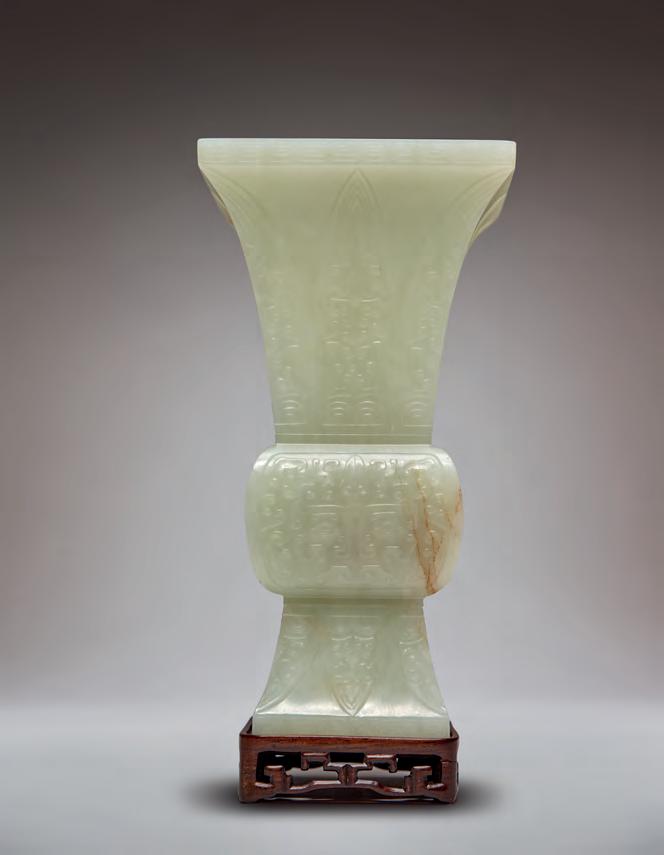
AROUND the HOUSES
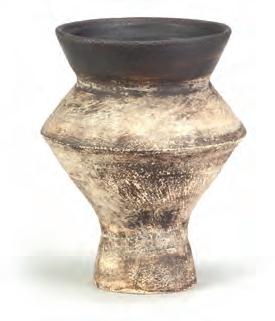
From a set of opium weigths to a tailless clockwork elephant, there has been much in recent sales to delight collectors
Woolley and Wallis, Salisbury
A rare, 18th-century celadon jade vase smashed its guide price of £10,000- £20,000 selling for £250,000 at the Wiltshire auctioneer’s sale on May 17.
The Qianlong vase, which has the four-character Qianlong Yu Wan mark on the base, came with a 1963 receipt from Spink & Son for £1,100, stating it came from the collection of Queen Maria of Yugoslavia, granddaughter of Queen Victoria.
It was inscribed with a poem on its base, composed by the Qianlong Emperor, a passionate collector of antiques, translating as: “Modern designs are too vulgar to use, and so instead I have imitated an archaic style.”
The lot came with a receipt stating it once belonged to the Queen of Yugoslavia
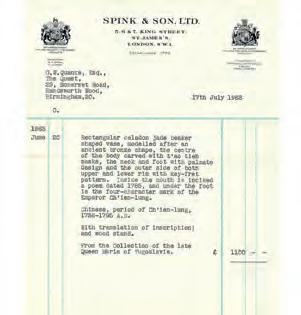
Noonans, Mayfair
A hoard of 142 Roman silver coins unearthed by three metal-detectorists in a Wiltshire field sold for £81,160 at the London auction house, (previously The Romanknown as Dix Noonan Webb) on May 17. hoard was
The hoard was buried around AD 410 unearthed over a when Emperor Honorius was recalled to weekend in Rome and Roman rule in Britain dwindled. Wiltshire
Noonans’ specialist, Nigel Mills, said: “As a result, Britain became a treasure island of late 4th century and early 5th century coins as the local population buried their valuables which then fell victim to Saxon raids.”
Adam Partridge, Macclesfield
A stoneware vase by Hans Coper (1920-1981), which was exhibited at the potter’s first one-man show in London in 1958, sold for £13,000 at the Cheshire auctioneer’s recent sale, beating its low presale estimate of £7,000.
A German Jew, Coper fled Germany for London in 1939 and, through a chance introduction, heard of a fellow refugee potter from Vienna who needed assistance in the production of ceramic buttons. So began the remarkable artistic partnership between Coper and Lucie Rie. Coper was given a solo exhibition by the gallerist The Henry Rothschild angular at Primavera, vase appeared Sloane Street, in Coper’s first in 1958, and its one-man show at success spurred Primavera future and fuller achievements.
Hansons, Etwell
An antique medicine chest uncovered in Leicester, still containing potions for ailments 210 years later, sold for £360 at the Derbyshire auctioneer’s recent sale.
The pink velvet interior of the rosewood apothecary box, c.1810, housed Gregory powder (made from rhubarb and used as a laxative), Epsom salts, soda, magnesia and belladonna (taken as a sedative, or to stop whooping cough).
Two lead compartments also contained ancient pills from ‘Savory & Moore, Chemists To The King, Belgrave Square, London’.
The medicine box, c. 1810, was found in Leicester and included ancient pills
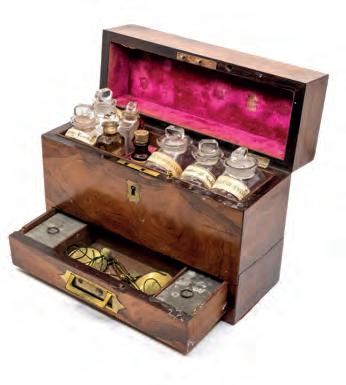
Lawrences, Crewkerne
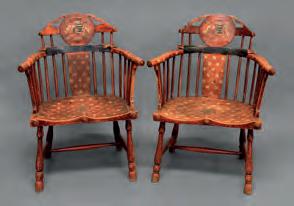
A pair of mid-18th-century red- painted Windsor armchairs, part of a suite, sold for £15,000 at the Somerset auctioneer’s recent sale.
The chairs, which were expected to make between £12,000-£15,000, had been made for John Perceval, 2nd Earl of Egmont (17111770) in about 1756, with a similar chair currently in the Victoria & Albert Museum. Other chairs from the suite have appeared at intervals, including another pair at Lawrences some years ago.
A similar polychrome Windsor chair is currently in the V&A
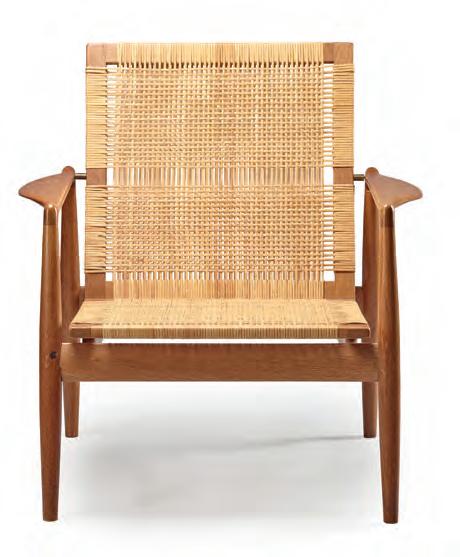
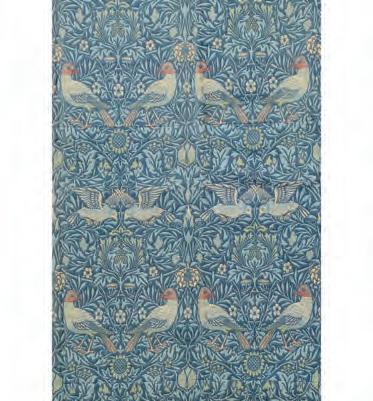
McTear’s, Glasgow
A skeleton clock given as a retirement gift in 1880 sold for three times its low estimate at the Scottish auctioneers when it was snapped up for £9,000 at auction in
The clock Glasgow. was given in Employees at Victorian shoemaker, recognition of Clarks of Kilmarnock, gave the 74.5cm-high a much-loved boss clock to the company’s founder George Clark engraving it with the words ‘...in recognition of his untiring energy and as a mark of their esteem and regard for him as their Employer.’
The clock is powered by a three train, triple fusee driven movement with quarter-striking on eight bells and hour-striking on a coil. It has a repeater mechanism with Roman numerals, lacquered brass case and a time-compensating mercury bob.
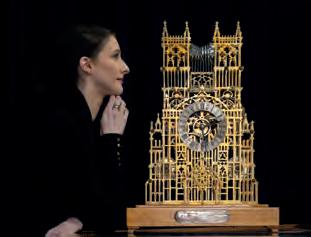
Lyon & Turnbull, Online
A mid-century teak and rattan chair by the Danish designer Finn Juhl (1912-1989) sold for more than three times its low estimate when it fetched £6,875 in an online sale at the auctioneer’s London saleroom.
It was designed in 1956 for the Danish maker Søren Willadsen, with which Juhl started his collaboration in 1949 creating a total of 15 designs.
Meanwhile, a pair of ‘Bird’ pattern curtains by William Morris (1834-1896) fetched £7,500, seven times its low estimate of £1,000, at an online auction at the auctioneer’s Edinburgh HQ.
The mid-century Danish chair beat its pre-sale estimate
William Morris designed the pattern for Morris & Co. in 1884
Sworders, Stansted Mountfitchet

Am 8cm-tall, 900-year-old bronze figure of a Buddhist deity, expected to make £400-£500, sold for a “shell-shocking” £273,000 at the Essex auction house’s Asian art sale on May 13. The diminutive piece, which depicts the four-faced, eightarmed goddess Amoghapasa (wisdom giver) was found in the bottom of a box of miscellaneous metalware by Sworders’ specialist, Yexue Li. The figure, made by the cire perdue (lost wax) casting process, dates towards the end of the Pala dynasty, which flourished from the 8th-12th century in far northeastern India. It is among the highest prices ever paid at auction for a Pala bronze.
The bronze figure was discovered at the bottom of a box of metalware
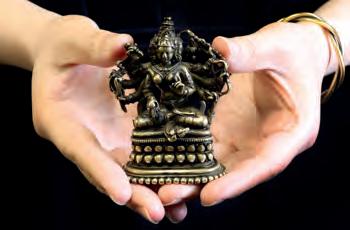
Olympia Auctions, London
Six 12th-century Burmese opium weights, depicting folklore animals, sold for £4,000 at the west London auction house, against a pre-sale guide of £300-£400.
Such pieces would have been used with balance scales in early commerce, sizes most commonly ranging in weight from ½ to 100 ticals (3.5lbs). Animal motfs were prevalent in Burmese mythology and religion, with weights, loom pulleys, textiles and household items commonly decorated with animal forms.
However, some debate exists, given their size, whether the weights were, in fact, used to weigh the narcotic.
The opium weights are decorated with images from Burmese folklore
Bishop & Miller, Stowmarket

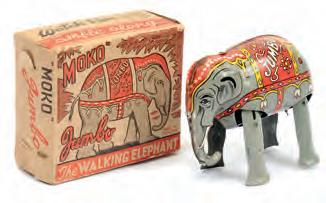
A late 17th-century olivewood cabinet-onstand, c. 1675-1690, sold for £30,000 at the Suffolk auctioneer’s oak sale on May 25. The oyster-veneered piece came from the celebrated Edward V. Phillips collection, as illustated in Country Life on June 3, 1982. It was presented with a receipt from ‘Trevor of Lewes’ dated the same year. Inside, 11 drawers The twosurround a central door day sale helped which opens to reveal three further drawers. A table with a similar spiral and ball leg put the Suffolk auction house on the map of oak specialistsdesign exists in the furniture collection at Beningbrough Hall, North Yorkshire. Having welcomed Bonhams’ former oak expert David Houlston as a consultant, the auction house is establishing itself as one of the country’s leading specialists in the field. Oliver Miller said: “Safe to say, the recent two-day oak auction was the best auction we have had and I think is now putting us up there as the oak auctioneers in the country – with some really great results on some absolutely wonderful pieces.”
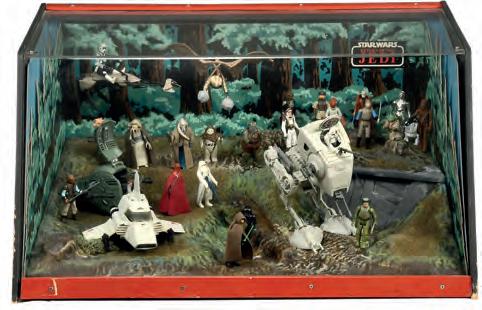
Dreweatts, Maidstone

The Chinese Imperial blue-glazed ‘Bat and Crane’ vase, which appeared on the cover of last month’s magazine, estimated to make £100,000-£150,000, sold for a cool £1.5m at the Berkshire auctioneer’s May 18 sale. Created in the 18th century for the court of the Qianlong Emperor, the vase was bought for a few hundred pounds in the 1980s and found in a kitchen, with its owner not realising its true value.
Setting a house record for the auctioneers, the 2ft-tall vase bears the distinctive sixcharacter mark of the Qianlong period (1736-1795) on its base. Its extremely rare enamelling techniques, using gold and silver against a vivid blue ground, helped push up the price. Such a vase would have required at least three firings.
The cover star of last month’s magazine turned out to be a saleroom star
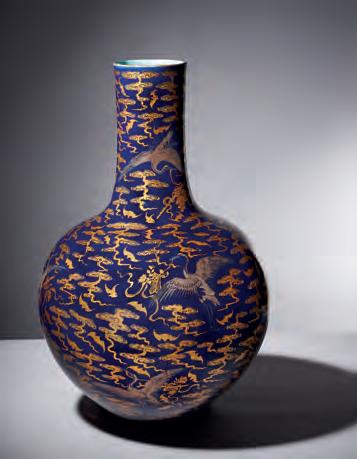
Vectis, Stocktonon-Tees
A toyshop promotional display sold for £15,600 at the North Yorkshire auction house’s recent sale – three times its low estimate. The ‘Star Wars Return of the Jedi’ display, which depicts the Moko Lesney produced early die-cast toys battle scene on Endor, had been on show under the at a Teeside shop, and was hand-built by NJ "Matchbox" Farmers Associates Ltd for Palitoy in the early name ’80s to promote the film.
Vectis specialist, Nick Dykes, said: “These large toy displays are fondly remembered by so many children, bringing back so many memories.” At another sale an early Matchbox Moko
The high Lesney tinplate clockwork elephant, price reflects who had lost its tail, beat its pre-sale the power of nostalgia expectation of £300 to sell for £2,160.
surrounding the famous franchise
Catherine Southon, Farleigh
The candlestick was given to John
A late 17th-century yellow gold Brown by Queen and enamel-decorated locket, c. 1690, sold for £4,000, against Victoria in 1871 an estimate of £500-£800, at the auctioneer’s Surrey saleroom.
The locket, which was discovered in a suitcase full of pieces, came with a lozenge inscribed ‘There is no sting in sweets I bring’.
At the same sale a silver candlestick believed to have been given by Queen Victoria to her personal attendant and court favourite John Brown (1826-1883) sold for £3,800, eclipsing its pre-sale guide price of £800-£1,200. The candlestick The 17th-century locket was discovered in a was engraved ‘From V R Xmas 1871’, and suitcase full of initialled J.B.’
trinkets

Fine Art Auctioneers & Valuers
NEXT AUCTION Tuesday 19 & Wednesday 20 July Fine Art & Antiques

PRINKNASH ABBEY PARK GLOUCESTERSHIRE GL4 8EU www.chorleys.com











